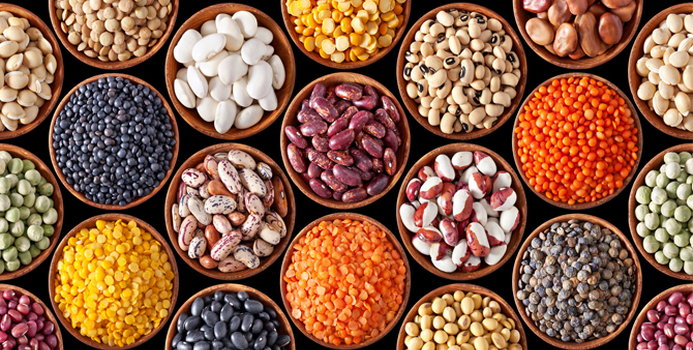Many vegetables contain some protein but aren't classified as high-protein foods. But protein-rich vegetables do exist, and can generally be counted as part of the vegetable or protein food groups. Because protein boosts satiety, increases your metabolism, and aids in healthy weight management, choosing high-protein foods is often beneficial. Women need at least 46 grams and men require a minimum of 56 grams of protein daily, suggests the Institute of Medicine.
Soybeans
You can count soybeans as part of the protein or vegetable food groups, according to the U.S. Department of Agriculture's ChooseMyPlate.gov. Soybeans are a source of high-quality, complete protein containing all essential amino acids, according to 2009 issue of American Family Physician. A cup of soybeans provides just over 22 grams of protein and 8 grams of fiber, notes the U.S. Department of Agriculture. Soybeans are also rich in calcium, iron, zinc, potassium, phosphorous, magnesium, B vitamins, folate, vitamin A and heart-healthy omega-3 fatty acids. Add cooked soybeans to salads and rice dishes, or eat it plain as edamame.
Green Peas
Loaded with protein, fiber, potassium, iron, zinc, folate, B vitamins, vitamin A and vitamin K, green peas fill you up and help meet many of your daily nutritional needs. A cup of cooked green peas provides almost 9 grams of protein and 9 grams of dietary fiber. Add green peas to salads, soups, stir fry, casseroles and rice dishes.
Chickpeas
Though chickpeas contain twice as many calories as green peas, they provide more protein as well. A cup of cooked chickpeas, also known as garbanzo beans, provides almost 15 grams of protein and 13 grams of dietary fiber. Chickpeas are also rich in zinc, iron, phosphorous, potassium, folate and vitamin K. Add chickpeas to salads, soups, veggie burgers and chili -- or try roasting chickpeas until they are crispy.
Lentils
A cup of cooked lentils provides you with almost 18 grams of protein and 16 grams of fiber, notes the U.S. Department of Agriculture. Lentils are also loaded with iron, zinc, phosphorous, potassium and folate. Lentils work great in soups, stews, salads, pasta or rice dishes, and veggie burgers.
Black Beans
Similar to other legumes, protein-rich black beans can be counted in either the vegetable or protein food groups. Black beans contain about 15 grams of protein and 15 grams of dietary fiber in each 1-cup cooked portion, notes the U.S. Department of Agriculture. These beans are also rich in iron, zinc, potassium, phosphorous and folate. Add black beans to casseroles, chili, salads, soups, dips, fajitas or egg-white omelets.
White Beans
White beans are higher in protein than black beans, providing over 17 grams of protein in each 1-cup cooked portion. These beans are also rich in fiber, calcium, iron, zinc, potassium, folate, vitamin E and vitamin K. White beans make an excellent addition to chili, soups, dips and salads.
Cooked Spinach
While spinach provides less protein than peas and beans, it also contains fewer calories. A cup of cooked spinachcontains just over 5 grams of protein per cup -- but provides just 41 calories, which is less than one-fourth of the number of calories in many legumes. Spinach is also rich in fiber, calcium, iron, zinc, potassium, magnesium, folate, and vitamins A, E and K. Add spinach to pasta or rice dishes, soups, salads, and egg-white omelets -- or sauté spinach with other veggies to make a nutrient-rich side dish.
Balancing Carbohydrate and Protein Intake In Your Diet
An experienced health, nutrition and fitness writer, Erin Coleman is a registered and licensed dietitian and holds a dietetics degree from the University of Wisconsin-Madison. She also has worked as a clinical dietitian and health educator in outpatient settings. Erin's work is published on popular health websites, such as TheNest.com and JillianMichaels.com.




